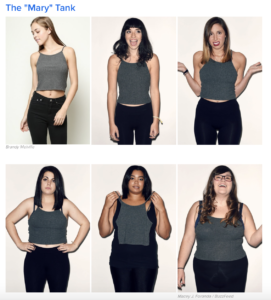“One Size Fits All” — a phrase that makes me, along with most women, shudder.
Maybe it’s because I usually don’t shop (and when I do it’s at Goodwill), but I really thought this “One Size” tag had gone away. Sadly, I was wrong. At my new job in retail I have discovered multiple articles of clothing claiming to fit everyone and every body type.
So I decided to give it a shot with a pair of dark green leggings. I could barely make it past my knees. At first, I felt embarrassed, chubby and angry, but then I realized that I’m not 12 years old anymore, and I actually have curves now.
As women, our weight fluctuates all the time. This is normal, ladies. Whether we’re going through stress or a hard time, or even a really good/exciting phase of life, our bodies react differently to each season.
Many thin women can feel threatened by the fact that the majority of people attack stores like Brandy Melville for catering to smaller sizes. But that’s not why these stores are attacked. They are attacked for the limited sizing, scarce variety in model types and even “cookie-cutter” retail associates who work in the front of the store.
Even during the interview process for stores like Brandy, a lot of applicants report that the store managers will take multiple pictures of them and what they’re wearing, not saying what the images are for. Ruby Seid, a sales associate for Brandy Melville, said she has noticed this bias as well.
“I think, to be honest, the real reason why they hired me is because I was a skinny, blonde, white girl,” Melville said.
 I hope that this is needless to say — but we need more variety! The idea of “One Size Fits All” goes past a pair of jeans and past the tall, skinny girl who is swiping your credit card. “One Size” has been subconsciously ruling women’s’ fashion for decades, and it is time to put an end to this “let’s be perfect” stigma in the fashion world.
I hope that this is needless to say — but we need more variety! The idea of “One Size Fits All” goes past a pair of jeans and past the tall, skinny girl who is swiping your credit card. “One Size” has been subconsciously ruling women’s’ fashion for decades, and it is time to put an end to this “let’s be perfect” stigma in the fashion world.
When I spoke to a few men about “One Size” to get both sides of the story, I heard an interesting overarching theme.
“I had actually never heard of ‘one size fits all’ until right now,” senior student Daniel Collier said. “I mean, I guess men have that with underwear and socks?”
Our young women of the world are feeling marginalized and questioning the way they look because they might not fit into a crop top at Brandy Melville. And it’s affecting all ages.
Kate Walker, a high-schooler, said she doesn’t even remember a time without that label.
“It was definitely hard when I would find the perfect shirt on a rack and see that it said, ‘One Size’ on the tag,” Walker said. “I’ve always had curves, and I know through experience that ‘One Size’ has never fit. I know I shouldn’t, but I still let it affect me.”
Even older girls like 25-year-old, Natalie Ayala, has had battles with her “One Size” demons.
“I mean at the end of the day, it’s about you and not how far you can shove your legs into a pair of pants before they just won’t go up any higher, even though the tag claims ‘One Size,’” Ayala shared. “When I’m out shopping with friends, I’ve just learned to laugh it off because who in the world is going to fit perfectly into the same pants that the girl before you did? As much as I wish the jeans from Sisterhood of The Traveling Pants existed, they do not. And they never will.”
It’s interesting how, physically, most women are trapped into being equally “one (small) size,” but society, as a whole, refuses to treat so many things that actually matter, equally. When I walk into stores and see the writing “One Size,” I’ve learned to stop shaming myself for not fitting into a size that someone else made for me.

